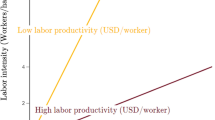Abstract
We investigate the problem of understanding the drivers of land use and its change in the southern Yucatán region. Our household data drawn from villages across the region show that as the amount of land devoted to crop cultivation has fallen, the amount of land devoted to pastureland has increased. We investigate this trend using a suite of three reinforcing investigative methods: (1) description and interpretation of direct evidence; (2) comparison of expected returns across main agricultural land uses; and (3) econometric modeling. We find that the increasing prominence of cattle ranching, or the prelude to it by planting pasture, is in part because of the constraints households face in family labor, one of the household’s key resources, and the relatively lower labor requirements of cattle ranching. The activity of cattle ranching fits particularly well with the constraints and incentives faced by the typical household in the region.
Similar content being viewed by others
References
Busch C (2006) Deforestation in Mexico’s southern Yucatan: recent trends, causes, policy implications. Unpublished doctoral dissertation, University of California, Berkeley
David PA (1969) A contribution to the theory of diffusion. Memorandum no. 71 (Stanford Center for Research in Economic Growth)
Deaton A (1997) The analysis of household surveys: a microeconomic approach to development policy. John Hopkins Press, Baltimore
Defries RS, Asner GP, Houghton R (2004) Trade-offs in land-use decisions: towards a framework for assessing multiple ecosystem responses to land-use change. Geophys Monogr Ser (American Geophysical Union) 153:1–9
Fernandez, JM, Hernández Bahena J (2002) Diagnostico comunitario del ejido Ricardo Payro Jene Municipio de Calakmul Campeche, Mexico. El Colegio de la Frontera Sur: Campeche, México
Geoghegan J, Cotrina Villar S, Klepeis P, Macario Mendoza P, Ogneva-Himmelberger Y, Roy Chowdhury R, Turner BL II, Vance C (2001) Modeling tropical deforestation in the southern Yucatán peninsular region: comparing survey and satellite data. Agric Ecosyst Environ 85:25–46
Goetz JS (1992) A selectivity model of household food marketing behavior in Sub-Saharan Africa. Am J Agric Econ 74:444–452
Gurri FD (2009) Adaptive strategies in migrant peasant households in Calakmul, Campeche, Mexico: preventing family fragmentation amongst agriculturists in areas of low population density (unpublished manuscript)
Heckman J (1979) Sample selection bias as a specification error. Econometric 47:153–161
Just RE, Zilberman D (1983) Stochastic structure, farm size and technology adoption in developing agriculture. Oxf Econ Pap 35:307–328
Key N, Sadoulet E, de Janvry A (2000) Transaction costs and agricultural household supply response. Am J Agric Econ 82(2):245–259
Keys E (2004) Jalapeño pepper cultivation: emergent commercial land use. In: Turner BL, Geoghegan JM, Foster DR (eds) Integrative land change science and tropical deforestation in the southern Yucatán: final frontiers (Clarendon lectures in geography and environmental studies). Oxford University Press, Oxford, pp 207–220
Keys E (2005) Exploring market based development: market intermediaries and farmers in Calakmul, Mexico. Geogr Rev 95(1):24–46
Klepeis P, Vance C (2003) Neoliberal policy and deforestation in Southeastern Mexico: an assessment of the PROCAMPO Program. Economic Geography 79(3):221–240
Manning WG, Duan D, Rogers WH (1987) Monte Carlo evidence on the choice between sample selection and two-part models. J Econom 35:59–82
Mather AS, Needle CL (1998) The forest transition: a theoretical basis. Area 30:117–124
McWilliams B, Zilberman D (1996) Time of technology adoption and learning by using. Econ Innov New Technol 4:139–154
Pichón FJ (1997) Colonist land-allocation decisions, land use, and deforestation in the Ecuadorian Amazon frontier. Economic Development and Cultural Change 44:127–164
Rudel TK, Bates D, Machinguiashi R (2002) A tropical forest transition? Agricultural change, out-migration and secondary forests in the Ecuadorian Amazon. Ann Assoc Am Geogr 92(1):87–102
Sadoulet E, de Janvry A, Benjamin C (1998) Labor market imperfections and selective recursiveness in household models. J Ind Relat 37(1):85–108
Schmook B, Radel C (2008) International labor migration from a tropical development frontier: globalizing households and an incipient forest transition the southern Yucatán case. Human Ecol (forthcoming)
Schneider LC (2006) The effect of land management practices on bracken fern invasion in the region of Calakmul, Mexico. J Lat Am Geogr 5(2):91–107
Tauchmann H (2005) Efficiency of two-step estimators for censored systems of equations: Shonkwiler and Yen reconsidered. Appl Econ 37:367–374
Vance C, Geoghegan J (2004) Modeling the determinants of semi-subsistent and commercial land uses in an agricultural frontier of southern Mexico: a switching regression approach. Int Reg Sci Rev 27:326–347
Vance C, Klepeis P, Schmook B, Keys E (2004) The ejido household: the current agent of change. In: Turner BL, Geoghegan JM, Foster DR (eds) Integrative land change science and tropical deforestation in the southern Yucatán: final frontiers. Oxford University Press, Oxford, pp 171–188 (Clarendon lectures in geography and environmental studies)
Walker R, Perez S, Caldas M, Teixeira Silva LG (2002) Land use and land cover change in forest frontiers: the role of the household life cycles. Int Reg Sci Rev 25(2):169–199
Acknowledgments
Thanks to the anonymous reviewers and Billie Turner for comments that have improved this article. Thanks to Birgit Schmook and our research assistants for their contributions to our cooperative data collection effort. Funding for the research was provided by the Global Change Education Program (a program of the US Department of Energy), and the University of California’s Institute for Study of Mexico, and the United States. This research was conducted in cooperation with the Southern Yucatán Peninsular Region project, which received core funding for NASA’s LCLUC program (NAG 56046, 511134, 06GD98G) and NSF’s BCS program (0410016). The project is indebted to assistance provided by our host institution in Mexico, El Colegiio de la Frontera Sur, especially Unidad Chetumal.
Author information
Authors and Affiliations
Corresponding author
Rights and permissions
About this article
Cite this article
Busch, C., Geoghegan, J. Labor scarcity as an underlying cause of the increasing prevalence of deforestation due to cattle pasture development in the southern Yucatán region. Reg Environ Change 10, 191–203 (2010). https://doi.org/10.1007/s10113-010-0110-z
Received:
Accepted:
Published:
Issue Date:
DOI: https://doi.org/10.1007/s10113-010-0110-z




